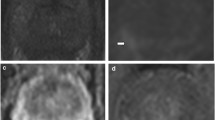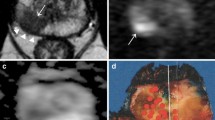Abstract
Objective
To determine if tumor cell density and percentage of Gleason pattern within an outlined volumetric tumor region of interest (TROI) on whole-mount pathology (WMP) correlate with apparent diffusion coefficient (ADC) values on corresponding TROIs outlined on pre-operative MRI.
Methods
Men with biopsy-proven prostate adenocarcinoma undergoing multiparametric MRI (mpMRI) prior to prostatectomy were consented to this prospective study. WMP and mpMRI images were viewed using 3D Slicer and each TROI from WMP was contoured on the high b-value ADC maps (b0, 1400). For each TROI outlined on WMP, TCD (tumor cell density) and the percentage of Gleason pattern 3, 4, and 5 were recorded. The ADCmean, ADC10th percentile, ADC90th percentile, and ADCratio were also calculated in each case from the ADC maps using 3D Slicer.
Results
Nineteen patients with 21 tumors were included in this study. ADCmean values for TROIs were 944.8 ± 327.4 vs. 1329.9 ± 201.6 mm2/s for adjacent non-neoplastic prostate tissue (p < 0.001). ADCmean, ADC10th percentile, and ADCratio values for higher grade tumors were lower than those of lower grade tumors (mean 809.71 and 1176.34 mm2/s, p = 0.014; 10th percentile 613.83 and 1018.14 mm2/s, p = 0.009; ratio 0.60 and 0.94, p = 0.005). TCD and ADCmean (ρ = −0.61, p = 0.005) and TCD and ADC10th percentile (ρ = −0.56, p = 0.01) were negatively correlated. No correlation was observed between percentage of Gleason pattern and ADC values.
Conclusion
DWI MRI can characterize focal prostate cancer using ADCratio, ADC10th percentile, and ADCmean, which correlate with pathological tumor cell density.




Similar content being viewed by others
References
Cancer Facts & Figures (2016) American Cancer Society, Atlanta
Wilt TJ, Brawer MK, Jones KM, et al. (2012) Radical prostatectomy versus observation for localized prostate cancer. N Engl J Med 367(3):203–213
Hamdy FC, Donovan JL, Lane JA, et al. (2016) 10-Year outcomes after monitoring, surgery, or radiotherapy for localized prostate cancer. N Engl J Med . doi:10.1056/NEJMoa1606221
Dinh KT, Mahal BA, Ziehr DR, et al. (2015) Incidence and predictors of upgrading and up staging among 10,000 contemporary patients with low risk prostate cancer. J Urol 194(2):343–349
Dinh KT, Muralidhar V, Mahal BA, et al. (2015) Occult high-risk disease in clinically low-risk prostate cancer with ≥50% positive biopsy cores: should national guidelines stop calling them low-risk? Urology . doi:10.1016/j.urology.2015.08.026
Barry MJ, Gallagher PM, Skinner JS, Fowler FJ (2012) Adverse effects of robotic-assisted laparoscopic versus open retropubic radical prostatectomy among a nationwide random sample of medicare-age men. J Clin Oncol 30(5):513–518
Ploussard G, Epstein JI, Montironi R, et al. (2011) The contemporary concept of significant versus insignificant prostate cancer. Eur Urol 60(2):291–303
Stark JR, Perner S, Stampfer MJ, et al. (2009) Gleason score and lethal prostate cancer: does 3 + 4 = 4 + 3? J Clin Oncol 27(21):3459–3464
Hricak H, Choyke PL, Eberhardt SC, Leibel SA, Scardino PT (2007) Imaging prostate cancer: a multidisciplinary perspective. Radiology 243(1):28–53
Turkbey B, Brown AM, Sankineni S, et al. (2015) Multiparametric prostate magnetic resonance imaging in the evaluation of prostate cancer. CA Cancer J Clin 40(7):2557–2565
Glazer DI, Davenport MS, Khalatbari S, et al. (2015) Mass-like peripheral zone enhancement on CT is predictive of higher-grade (Gleason 4 + 3 and higher) prostate cancer. Abdom Imaging 40(3):560–570
Epstein JI, Zelefsky MJ, Sjoberg DD, et al. (2015) A contemporary prostate cancer grading system: a validated alternative to the gleason score. Eur Urol . doi:10.1016/j.eururo.2015.06.046
Sauter G, Steurer S, Clauditz TS, et al. (2015) Clinical utility of quantitative gleason grading in prostate biopsies and prostatectomy specimens. Eur Urol . doi:10.1016/j.eururo.2015.10.029
Ankerst DP, Hoefler J, Bock S, et al. (2014) Prostate cancer prevention trial risk calculator 2.0 for the prediction of low- vs high-grade prostate cancer. Urology 83(6):1362–1367
Kweldam CF, Wildhagen MF, Steyerberg EW, et al. (2015) Cribriform growth is highly predictive for postoperative metastasis and disease-specific death in Gleason score 7 prostate cancer. Mod Pathol 28(3):457–464
Dong F, Yang P, Wang C, et al. (2013) Architectural heterogeneity and cribriform pattern predict adverse clinical outcome for Gleason grade 4 prostatic adenocarcinoma. Am J Surg Pathol 37(12):1855–1861
Radtke JP, Schwab C, Wolf MB, et al. (2016) Multiparametric magnetic resonance imaging (MRI) and MRI-transrectal ultrasound fusion biopsy for index tumor detection: correlation with radical prostatectomy specimen. Eur Urol . doi:10.1016/j.eururo.2015.12.052
Delongchamps NB, Lefèvre A, Bouazza N, et al. (2015) Detection of significant prostate cancer with magnetic resonance targeted biopsies–should transrectal ultrasound-magnetic resonance imaging fusion guided biopsies alone be a standard of care? J Urol 193(4):1198–1204
Weinreb JC, Barentsz JO, Choyke PL, et al. (2016) PI-RADS Prostate Imaging–Reporting and Data System: 2015, Version 2. Eur Urol 69(1):16–40
Vargas HA, Akin O, Franiel T, et al. (2011) Diffusion-weighted endorectal MR imaging at 3 T for prostate cancer: tumor detection and assessment of aggressiveness. Radiology 259(3):775–784
Kim TH, Jeong JY, Lee SW, et al. (2015) Diffusion-weighted magnetic resonance imaging for prediction of insignificant prostate cancer in potential candidates for active surveillance. Eur Radiol 25(6):1786–1792
Boesen L, Chabanova E, Løgager V, Balslev I, Thomsen HS (2015) Apparent diffusion coefficient ratio correlates significantly with prostate cancer gleason score at final pathology. J Magn Reson Imaging 42(2):446–453
Hambrock T, Somford DM, Huisman HJ, et al. (2011) Relationship between apparent diffusion coefficients at 3.0-T MR imaging and Gleason grade in peripheral zone prostate cancer. Radiology 259(2):453–461
Mazaheri Y, Shukla-Dave A, Hricak H, et al. (2008) Prostate cancer: identification with combined diffusion-weighted MR imaging and 3D 1H MR spectroscopic imaging—correlation with pathologic findings. Radiology 246(2):480–488
Oto A, Kayhan A, Jiang Y, et al. (2010) Prostate cancer: differentiation of central gland cancer from benign prostatic hyperplasia by using diffusion-weighted and dynamic contrast-enhanced MR imaging. Radiology 257(3):715–723
Donati OF, Mazaheri Y, Afaq A, et al. (2014) Prostate cancer aggressiveness: assessment with whole-lesion histogram analysis of the apparent diffusion coefficient. Radiology 271(1):143–152
Rosenkrantz AB, Triolo MJ, Melamed J, et al. (2015) Whole-lesion apparent diffusion coefficient metrics as a marker of percentage Gleason 4 component within Gleason 7 prostate cancer at radical prostatectomy. J Magn Reson Imaging 41(3):708–714
Fedorov A, Penzkofer T, Hirsch MS, et al. (2015) The role of pathology correlation approach in prostate cancer index lesion detection and quantitative analysis with multiparametric MRI. Acad Radiol 22(5):548–555
Fennessy FM, Fedorov A, Penzkofer T, et al. (2015) Quantitative pharmacokinetic analysis of prostate cancer DCE-MRI at 3T: comparison of two arterial input functions on cancer detection with digitized whole mount histopathological validation. Magn Reson Imaging 33(7):886–894
Hegde JV, Mulkern RV, Panych LP, et al. (2013) Multiparametric MRI of prostate cancer: an update on state-of-the-art techniques and their performance in detecting and localizing prostate cancer. J Magn Reson Imaging 37(5):1035–1054
Trivedi H, Turkbey B, Rastinehad AR, et al. (2012) Use of patient-specific MRI-based prostate mold for validation of multiparametric MRI in localization of prostate cancer. Urology 79(1):233–239
Fedorov A, Beichel R, Kalpathy-Cramer J, et al. (2012) 3D Slicer as an image computing platform for the Quantitative Imaging Network. Magn Reson Imaging 30(9):1323–1341
Jonmarker S, Valdman A, Lindberg A, Hellström M, Egevad L (2006) Tissue shrinkage after fixation with formalin injection of prostatectomy specimens. Virchows Arch 449(3):297–301
Stamey TA, Freiha FS, McNeal JE, et al. (1993) Localized prostate cancer. Relationship of tumor volume to clinical significance for treatment of prostate cancer. Cancer 71(3 Suppl):933–938
Wolters T, Roobol MJ, van Leeuwen PJ, et al. (2011) A critical analysis of the tumor volume threshold for clinically insignificant prostate cancer using a data set of a randomized screening trial. J Urol 185(1):121–125
Kuwano H, Miyazaki T, Tsutsumi S, et al. (2004) Cell density modulates the metastatic aggressiveness of a mouse colon cancer cell line, colon 26. Oncology 67(5–6):441–449
Pernicová Z, Slabáková E, Fedr R, et al. (2014) The role of high cell density in the promotion of neuroendocrine transdifferentiation of prostate cancer cells. Mol Cancer 13:113
Tollefson MK, Leibovich BC, Slezak JM, Zincke H, Blute ML (2006) Long-term prognostic significance of primary Gleason pattern in patients with Gleason score 7 prostate cancer: impact on prostate cancer specific survival. J Urol 175(2):547–551
Vargas HA, Hötker AM, Goldman DA, et al. (2015) Updated prostate imaging reporting and data system (PIRADS v2) recommendations for the detection of clinically significant prostate cancer using multiparametric MRI: critical evaluation using whole-mount pathology as standard of reference. Eur Radiol . doi:10.1007/s00330-015-4015-6
Gibbs P, Liney GP, Pickles MD, et al. (2009) Correlation of ADC and T2 measurements with cell density in prostate cancer at 3.0 Tesla. Investig Radiol 44(9):572–576
Zelhof B, Pickles M, Liney G, et al. (2009) Correlation of diffusion-weighted magnetic resonance data with cellularity in prostate cancer. BJU Int 103(7):883–888
Chatterjee A, Watson G, Myint E, et al. (2015) Changes in epithelium, stroma, and lumen space correlate more strongly with Gleason Pattern and are stronger predictors of prostate ADC changes than cellularity metrics. Radiology 277(3):751–762
Bollineni VR, Kramer G, Liu Y, Melidis C, deSouza NM (2015) A literature review of the association between diffusion-weighted MRI derived apparent diffusion coefficient and tumour aggressiveness in pelvic cancer. Cancer Treat Rev 41(6):496–502
Turkbey B, Shah VP, Pang Y, et al. (2011) Is apparent diffusion coefficient associated with clinical risk scores for prostate cancers that are visible on 3-T MR images? Radiology 258(2):488–495
Acknowledgments
The authors thank Louise Greenberg, M.Ed. for coordination of this study and Nina Geller Ph.D. for editing assistance.
Grant Support
Grant funding was provided by U01CA151261 (FMF, AF), U24CA180918 (AF), R25CA89017 (DIG), P41EB015898 (CT, FF, AF), and DPH403516 (EH).
Author information
Authors and Affiliations
Corresponding author
Ethics declarations
Conflict of Interest
None.
Ethical approval
The study was HIPAA compliant and approved by the Institutional Review Board. Informed consent was obtained from all individual participants included in the study. All procedures performed in studies involving human participants were in accordance with the ethical standards of the institutional and/or national research committee, and with the 1964 Helsinki declaration and its later amendments or comparable ethical standards.
Rights and permissions
About this article
Cite this article
Glazer, D.I., Hassanzadeh, E., Fedorov, A. et al. Diffusion-weighted endorectal MR imaging at 3T for prostate cancer: correlation with tumor cell density and percentage Gleason pattern on whole mount pathology. Abdom Radiol 42, 918–925 (2017). https://doi.org/10.1007/s00261-016-0942-1
Published:
Issue Date:
DOI: https://doi.org/10.1007/s00261-016-0942-1




